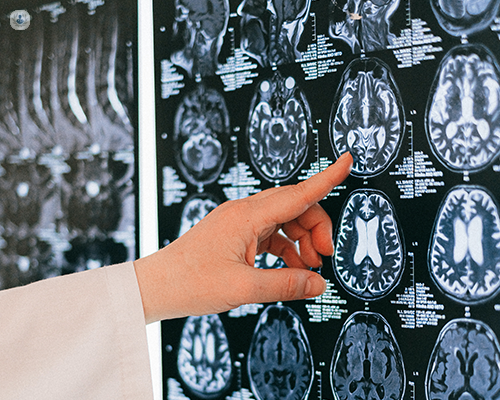Understanding brain tumour types: Symptoms, diagnosis, and treatment options
Escrito por:A brain tumour is an abnormal growth of cells within or around the brain, which may be benign (non-cancerous) or malignant (cancerous).
Mr Anastasios Giamouriadis, renowned consultant neurosurgeon and brain and spinal surgeon, provides expert insights into the various types of brain tumours, examining their symptoms, diagnostic techniques, and treatment options.

What are the different types of brain tumours?
Brain tumours can be divided into two primary categories: primary tumours and secondary tumours.
Primary brain tumours
Primary brain tumours originate in the brain. There are several types, including:
- Gliomas: These tumours originate from glial cells, which offer support and protection to neurons. Gliomas include astrocytomas (high-grade variants can cause persistent headaches and seizures), oligodendrogliomas (which cause similar symptoms as astrocytomas), and ependymomas (which lead to headaches, nausea, and symptoms related to increased intracranial pressure).
- Meningiomas: These tumours develop in the meninges, which are the protective membranes that surround the brain. Meningiomas are typically benign and may cause symptoms like headaches, vision problems, and seizures.
- Medulloblastomas: These tumours form in the cerebellum, which is the structure located at the back of the brain. Symptoms may include problems with coordination, headaches, vomiting, and changes in behaviour.
- Schwannomas: These tumours develop from Schwann cells, which are specialised cells in the peripheral nervous system. The most common type of schwannoma are vestibular schwannomas, which affect the eighth cranial nerve and can cause hearing loss, tinnitus, and balance problems.
Secondary brain tumours
Secondary brain tumours originate from cancers that have metastasised (spread) to the brain from other parts of the body. Symptoms often resemble those of primary tumours, including headaches, seizures, and neurological deficits.
How are brain tumours diagnosed?
When a patient presents symptoms suggestive of a brain tumour, neurosurgeons will typically start with a thorough medical history and a neurological examination to assess motor and sensory skills, coordination, and cognitive function.
Imaging tests will then be conducted. The most common include:
- MRI: An MRI is the preferred technique for visualising brain tumours. It produces detailed images of brain structures and helps in determining the size, location, and type of the tumour.
- CT scan: A CT scan may be used in emergency situations or when an MRI isn’t available. It helps in identifying brain tumours and can reveal bleeding or swelling in the brain.
In some cases, a biopsy will be required to confirm the diagnosis and determine the type of tumour. During this procedure, a small tissue sample will be taken from the tumour and analysed under a microscope. This can be done through various methods, such as a stereotactic needle biopsy or an open surgical biopsy.
Once the diagnosis is confirmed, further tests may be conducted to assess the tumour's grade, which indicates how aggressive the cancer is. This grading will help guide future treatment decisions and provide information on the prognosis.
Can brain tumours be treated?
The treatment of brain tumours depends on several factors, including the type and grade of the tumour, its location, and the overall health of the patient. Treatment options may include:
Neurosurgery
Surgical removal of the tumour is often the first line of treatment, especially for accessible tumours. The goal of neurosurgery is to excise as much of the tumour as possible while preserving the surrounding brain tissue.
Radiotherapy
Radiotherapy uses high-energy rays to destroy cancer cells. It may be administered after surgery to eliminate any remaining cancer cells or as the primary treatment for tumours that can’t be surgically removed. Stereotactic radiosurgery, a non-invasive procedure that accurately targets radiation to the tumour, is also available for specific patients.
Chemotherapy
Chemotherapy involves the use of drugs to eliminate cancer cells or slow their growth, and is often administered in combination with surgery and radiation, particularly for aggressive tumours like glioblastomas.
Additionally, patients may consider participating in clinical trials that investigate new treatment methods or medications. These trials can offer access to advanced therapies that aren’t yet widely available.
If you would like to book an appointment with Mr Anastasios Giamouriadis, head on over to his Top Doctors profile today.


